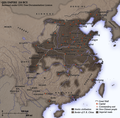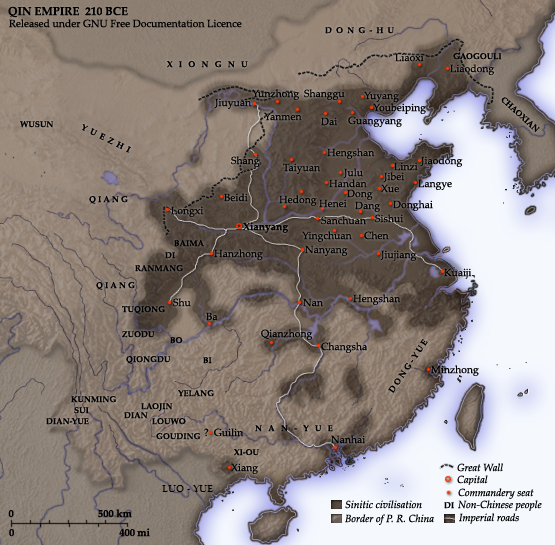文件:Qin empire 210 BCE.png
Qin_empire_210_BCE.png (555 × 545 chiông-só, ùng-giông duâi-nâung: 567 KB,MIME lôi-hìng: image/png)
Ùng-giông lĭk-sṳ̄
Sōng-dĕk siŏh bĭk nĭk-gĭ/sì-găng lì káng hiā sèng-hâiu gì ùng-giông.
| Nĭk-gĭ/Sì-găng | Sáuk-liŏk-dù | Chióh-cháung | Ê̤ṳng-hô | Suók-mìng | |
|---|---|---|---|---|---|
| hiêng-káik-sì | 2014 nièng 12 nguŏk 10 hô̤ (B3) 14:37 |  | 555 × 545(567 KB) | Nguyen1310 | Update to include ''Luo-Yue'' (Vi: ''Lạc Việt'') a member of the Baiyue (100 Yue) peoples, on the map in northern Vietnam. |
| 2006 nièng 11 nguŏk 21 hô̤ (B2) 14:08 |  | 555 × 545(540 KB) | Itsmine | == Commentary == As part of his unification of China in 221 BC, Qin Shi Huang divided his empire into thirty six commanderies, each subdivided into a number of counties. The significance of the administrative reforms was its in |
Lièng-giék
Â-dā̤ gì hiĕk-miêng lièng gáu ciā ùng-giông:
Cuòng-mĭk ùng-giông sāi-ê̤ṳng cìng-huóng
Â-dā̤ gì gì-tă wiki găk lā̤ sāi cī-bĭh ùng-giông:
- af.wikipedia.org gì sāi-ê̤ṳng cìng-huóng
- ar.wikipedia.org gì sāi-ê̤ṳng cìng-huóng
- ast.wikipedia.org gì sāi-ê̤ṳng cìng-huóng
- bg.wikipedia.org gì sāi-ê̤ṳng cìng-huóng
- bo.wikipedia.org gì sāi-ê̤ṳng cìng-huóng
- br.wikipedia.org gì sāi-ê̤ṳng cìng-huóng
- bxr.wikipedia.org gì sāi-ê̤ṳng cìng-huóng
- ca.wikipedia.org gì sāi-ê̤ṳng cìng-huóng
- cs.wikipedia.org gì sāi-ê̤ṳng cìng-huóng
- cv.wikipedia.org gì sāi-ê̤ṳng cìng-huóng
- cy.wikipedia.org gì sāi-ê̤ṳng cìng-huóng
- da.wikipedia.org gì sāi-ê̤ṳng cìng-huóng
- de.wikipedia.org gì sāi-ê̤ṳng cìng-huóng
- en.wikipedia.org gì sāi-ê̤ṳng cìng-huóng
- es.wikipedia.org gì sāi-ê̤ṳng cìng-huóng
- eu.wikipedia.org gì sāi-ê̤ṳng cìng-huóng
- fa.wikipedia.org gì sāi-ê̤ṳng cìng-huóng
- fr.wikipedia.org gì sāi-ê̤ṳng cìng-huóng
- ga.wikipedia.org gì sāi-ê̤ṳng cìng-huóng
- gl.wikipedia.org gì sāi-ê̤ṳng cìng-huóng
- hak.wikipedia.org gì sāi-ê̤ṳng cìng-huóng
- he.wikipedia.org gì sāi-ê̤ṳng cìng-huóng
- hi.wikipedia.org gì sāi-ê̤ṳng cìng-huóng
- hr.wikipedia.org gì sāi-ê̤ṳng cìng-huóng
- id.wikipedia.org gì sāi-ê̤ṳng cìng-huóng
- incubator.wikimedia.org gì sāi-ê̤ṳng cìng-huóng
- jv.wikipedia.org gì sāi-ê̤ṳng cìng-huóng
- ka.wikipedia.org gì sāi-ê̤ṳng cìng-huóng
檢視此檔案的更多全域使用狀況。




